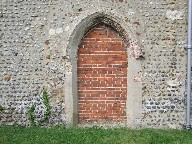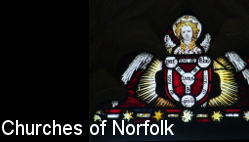| |
|
St Peter,
Strumpshaw I had been cycling around the area to the
north of Acle, where virtually all the churches are open
everyday. The churches were a pleasure, but the roads
were not, because even in spring they were thunderous
with traffic. While the smaller country roads are
pleasant enough, there are so few crossing points of the
various rivers that all the traffic comes together. The
Acle to Stalham road is not one I would recommend to any
cyclist.
In one
sense, then, it was a relief to cross the Bure at Acle
again and head south into the quiet, pretty rolling
lanes, threading their way through fields and copses. But
I knew that I was entering one of Norfolk's few areas of
locked churches, which is always a bit depressing when
you are hoping to visit them, and here at Strumpshaw even
the keyholder notices ran out. No welcome for pilgrims
and strangers here. And so this medieval building which
has stood for centuries, a beating heart of its faith
community and a touchstone down the long Strumpshaw
generations, is no longer in use for its proper purpose.
| As
if to accentuate this, St Peter is a tall,
forbidding building. The late 15th Century tower
has been left stark by its 1890s restoration.
When they restored the long nave in the early
19th Century, they lowered the roof, and this
only adds to the severity of the tower. One of my
regular correspondents, who had seen inside the
building on a Historic Churches Bike Ride day,
tells me that he thinks I haven't missed much, as
the interior is one of the dullest of any
medieval church in Norfolk. But I would like to
have seen the remains of the screen, which
Cautley thought, in construction, must have been
much like the famous one at Ranworth. Instead,
all I could do was potter around the graveyard,
where I found a couple of delightfully deeply cut
reliefs and several memorials to the Coffin
family, one of whom, dying in 1781, had been 56
years clerk of this parish, which at last
gave me an inkling of those long generations.
Though it seemed a shame that the most
interesting and welcoming thing about Strumpshaw
was the dead.
|
|
 |
|
|
|
